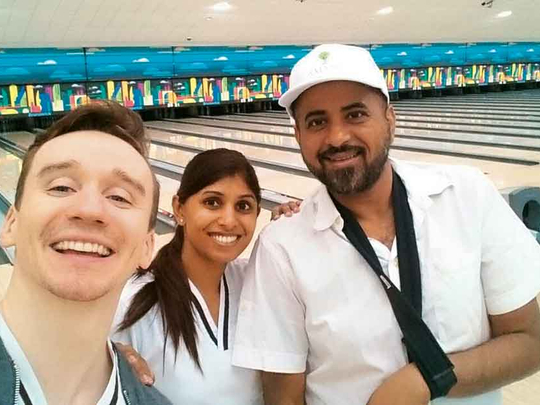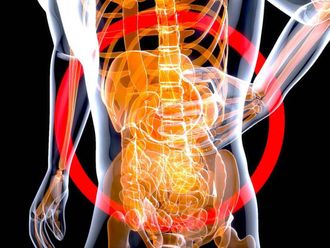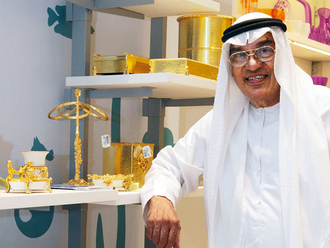
On September 12, 2016, 48-year-old Mubarak Abdulla Omar headed to Abu Dhabi airport to travel to Cairo. He felt relaxed and rested as he reached the airport, racing to complete formalities to board the flight.
“I suddenly experienced a strange throbbing in my head, breaking out in cold sweat,” says Omar. “Next, I felt terribly weak and dizzy. I took a few deep breaths to mitigate the symptoms but it didn’t work. I knew something was wrong when the left side of my body became numb and my face droopy. Shortly after that I collapsed.”
Omar was rushed to a hospital in Abu Dhabi for emergency treatment. Tests revealed he suffered a cerebral lacunar stroke with left-sided weakness of the face, arm and leg. “Earlier that day, I’d felt a bit fatigued, along with tingling in my arms and legs,” explains the Emirati. “I was not aware of the warning signs of strokes, so I didn’t pay any attention to these symptoms. If I recognised what was going on in my body, I could have possibly avoided the severity of the stroke.”
One of the most common types, lacunar stroke results from a blockage in one of the arteries that provides blood to the brain’s deep structures. High blood pressure is a critical risk factor for this type.
“I had uncontrolled diabetes, high blood pressure and cholesterol,” says Omar. “All these, combined with stress and smoking, caused the stroke.”
After a week at the hospital, Omar was moved to Amana Healthcare Medical and Rehabilitation Hospital, also in Abu Dhabi, for a 90-day rehabilitation programme to regain his lost physical movement.
“Omar had weakness in the left side of his body, more so in the arm than the leg, at the time of admission at Amana Healthcare,” says Dr Khalid Anwar, Consultant in Physical Medicine and Rehabilitation at Amana Healthcare Medical and Rehabilitation Hospital. “He also had low muscle tone. He was unable to transfer himself or walk and required nursing assistance in daily activities. He had very high blood sugar and high and fluctuating blood pressure.
Following three months of intensive rehabilitation, he was able to walk out of Amana fully independent in all activities of daily living and return to work.”
Cerebrovascular accidents, or strokes, are the second-leading cause of death and the third-leading cause of disability worldwide, according to the WHO. However, prompt treatment, complete with effective rehabilitation therapies, can prevent long-term disability in stroke patients. “Proper stroke management involves three essential elements: timely treatment in an acute stroke unit, followed by a period of rehabilitation in a dedicated stroke unit under the care of a specialised rehabilitation team and modification of risk factors and lifestyle changes,” explains Dr Anwar.
While early acute treatment minimises damage to the brain and prevents further complications, a growing body of evidence indicates that patients requiring rehabilitation should have timely access to a multidisciplinary team comprising rehabilitation physicians, specialist nurses, physiotherapists, occupational therapists, speech and language therapists, dietitian, social worker and neuro-psychologist to expedite their recovery and improve quality of life.
“A post-acute rehabilitation programme involves assessing the patient in detail, documenting all impairments and then formulating a rehab programme with the aim of increasing the functional status of the patient and minimising the effects of stroke so that the patient is able to resume his normal life,” says Dr Anwar. “A rehabilitation programme always sets specific long-term goals and weekly short-term goals. These goals are reviewed on a weekly basis and the team works towards attaining the long-term goals.”
Omar adds, “The rehabilitation treatment at Amana Healthcare, involving physio and speech therapies, and education and tips on preventing further incidences of stroke, helped me return to a normal life fast. While I still have a bit of difficulty in my left arm, I am exercising regularly to regain my full strength.
“Though I have not been able to completely quit smoking, I have reduced the number of cigarettes I smoke daily. I also take my medications regularly to keep my blood sugar in check.”
Dr Anwar highlights that an important part of a rehabilitation programme is educating the patient and their family about the risk factors for a stroke to help reduce recurrence.
For him, stroke is something that can be prevented in many cases. There are identifiable risk factors, some of which are modifiable while others are not, he says. Some of the most important modifiable risk factors include hypertension, diabetes, smoking, hyperlipidaemia, obesity, high alcohol consumption and certain heart conditions including ischemic heart disease and atrial fibrillation (irregular heartbeat).
“Most of these risk factors are due to unhealthy lifestyles and diet,” says Dr Anwar. “About 70 per cent of strokes can be avoided by preventive measures and lifestyle modifications. Hypertension, or high blood pressure, is the single biggest risk factor for stroke. It is a silent killer and if it’s not treated properly, it increases a person’s stroke risk by four to six times. Similarly, early diagnosis and treatment of diabetes and heart conditions such as atrial fibrillation can help prevent a stroke.”
Omar urges people to seek as much information as possible on strokes to reduce their risk of one. “With a very high incidence of diabetes and high blood pressure, healthcare organisations in the UAE must work together to educate people on the warning signs of stroke. You must also listen to your body. If something is wrong, get professional help right away.”












